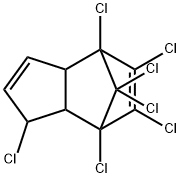헵타클로르 C화학적 특성, 용도, 생산
개요
Heptachlor is a soft, white to light tan, waxy, non-combustible, crystalline solid with a
camphor-like odour. Heptachlor is a member of the cyclodiene group of chlorinated insecticides
(aldrin, dieldrin, endrin, chlordane, heptachlor, and endosulfan) and has a long
history following World War II. It was registered as a commercial pesticide in 1952 for
foliar, soil, and structure applications and for malarial control programmes; after 1960,
it was used primarily in soil applications against agricultural pests and to a lesser extent
against termites.
Heptachlor is available commercially as a dust, a dust concentrate, an emulsifiable concentrate,
a wettable powder, or in oil solutions. It is corrosive to metals and reacts with iron
and rust to form hydrogen chloride gas. Heptachlor is incompatible with many amines,
nitrides, azo/diazo compounds, alkali metals, and epoxides but is stable under normal
temperatures and pressures. It may burn, but does not ignite readily. Heptachlor at high
heat and temperature produces highly toxic, corrosive fumes of hydrogen chlorine gas and toxic oxides of carbon. An important metabolite of heptachlor is heptachlor epoxide
which is an oxidation product formed from heptachlor by many plant and animal species.
Heptachlor is almost insoluble in water but soluble in ether, acetone, benzene, and many
other organic solvents.
화학적 성질
Heptachlor is an organochlorine cyclodiene insecticide isolated from technical chlordane.
It is available in the form of white crystals or a tan-colored waxy solid with a characteris-
tic camphor-like or cedar-like odor. It is sparingly soluble or insoluble in water, but fairly
soluble in acetone, benzene, ethanol, xylene, and other organic solvents. It is used for the
control of termites, ants, and soil insects in cultivated and non-cultivated soils. Heptachlor
epoxide is formed in nature when heptachlor is released into the environment and mixes with oxygen. Heptachlor epoxide remains in the soil for long periods of time. Heptachlor
and heptachlor epoxide may also be present at numerous hazardous waste sites. Although
the use of heptachlor is restricted, exposure to the general population does occur through
the ingestion of contaminated food.
물리적 성질
Colorless to light tan, waxy or crystalline, nonflammable solid with a camphor-like odor
용도
Heptachlor is used for the control of termites, ants, household
insects and soil insects. It is also applied as a seed treatment, soil treatment
or directly to foliage.
제조 방법
Heptachlor may be synthesized
by reacting chlordene with N-bromosuccinimide
to give the intermediate 1-bromochlordene followed by
chlorination with hydrogen chloride in nitromethane in
the presence of aluminum trichloride.
정의
ChEBI: A cyclodiene organochlorine insecticide that is 3a,4,7,7a-tetrahydro-1H-4,7-methanoindene substituted by chlorine atoms at positions 1, 4, 5, 6, 7, 8 and 8. Formerly used to kill termites, ants and other insects in agricultural and domes
ic situations.
일반 설명
HEPTACHLOR is a white to light tan waxy looking solid. Noncombustible. Insoluble in water. Can cause illness by inhalation, skin absorption and/or ingestion. The primary hazard is the threat posed to the environment. Immediate steps should be taken to limit its spread to the environment. Used as an insecticide.
공기와 물의 반응
Susceptible to epoxidation. Insoluble in water. Slowly losses hydrogen chloride in the presence of alkaline solution.
반응 프로필
HEPTACHLOR is incompatible with strong alkalis. Corrosive to metals. Can react with iron and rust to form toxic gases. Can react vigorously with oxidizing materials. Susceptible to epoxidation . May be incompatible with many amines, nitrides, azo/diazo compounds, alkali metals, and epoxides.
위험도
Toxic by ingestion, inhalation, and skin
absorption; use has been restricted and discontinued except for termite control. Possible carcinogen.
건강위험
Exposures to heptachlor epoxide cause adverse health effects to animals and humans.
Exposure to heptachlor is toxic by mouth, by skin contact, as well as by inhalation of dust
from powder concentrates. Heptachlor acts as a CNS stimulant. Prolonged period of expo-
sures to high concentrations of heptachlor cause headache, dizziness, nausea, vomiting,
weakness, irritability, salivation, lethargy, respiration distress, muscle tremors, convul-
sions, and paralysis. Severe cases of poisoning lead to respiratory failure and death. In
fact, seizures and cortical excitability are the prime CNS symptoms following acute hepta-
chlor exposure. The photoisomer of heptachlor (photoheptachlor) and the major metabo-
lite of heptachlor, namely, heptachlor epoxide are more toxic than the parent compound.
Heptachlor induces tremors, convulsions, paralysis, and hypothermia in rats and young
calves. The poisoned animals showed muscle spasms in the head and neck region, convul-
sive seizures, elevated body temperatures, and engorged brain blood vessels.
Humans exposed to heptachlor in the home during termite control operations showed
signs of neurotoxicity, i.e., irritability, salivation, lethargy, dizziness, labored respiration,
muscle tremors, convulsions, and death due to respiratory failure. Heptachlor interfered
with nerve transmission, caused hyperexcitation of the CNS, lethargy, incoordination,
tremors, convulsions, stomach cramps or pain, leading to coma and death.
화재위험
Special Hazards of Combustion Products: Irritating hydrogen chloride fumes may form in fire.
신진 대사 경로
Heptachlor is quite stable and resistant to environmental degradation.
Metabolic processes by which it undergoes transformation are
epoxidation, hydrolysis and dechlorination. It is transformed into a
variety of products, many of which differ from one another only in
stereochemical features while retaining the carbon skeleton and the
chlorinated norbornene moiety. The main biological metabolite is exoepoxyheptachlor.
Products formed by sensitised photolysis have caged
structures and undergo reactions that are typical of this class.
헵타클로르 준비 용품 및 원자재
원자재
준비 용품









